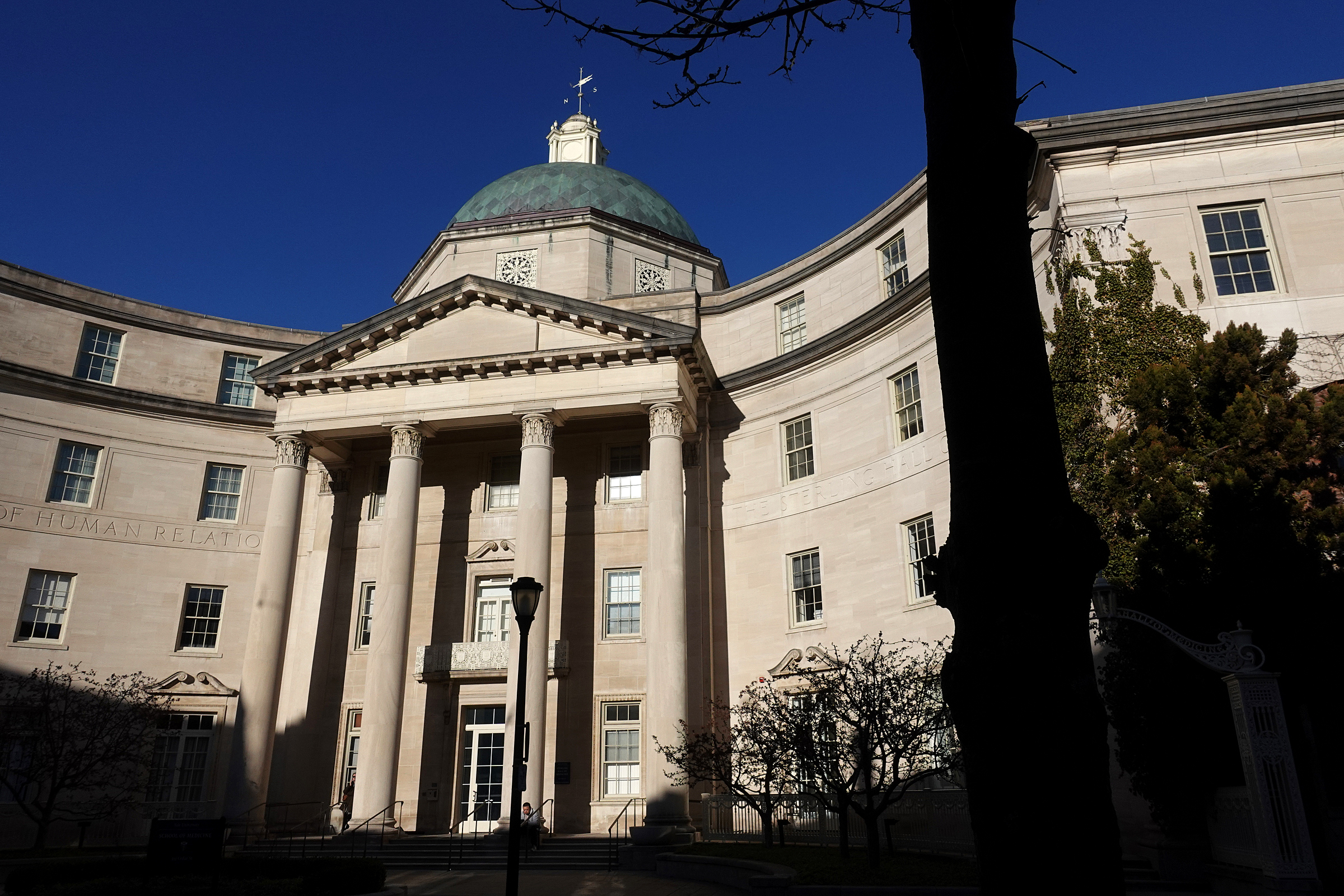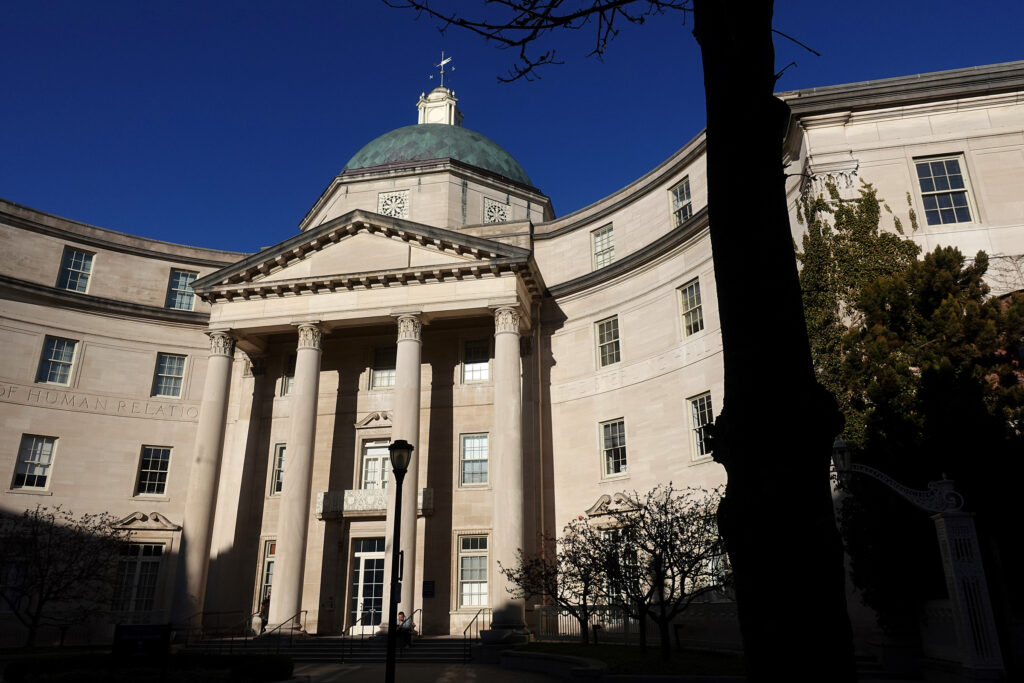
Tim Tai
Yale researchers are confronting a sharp decline in federal science funding, as grant terminations, stalled disbursements and proposed budget cuts disrupt labs and raise concerns about the future of university-based research.
Over the past several months, researchers across Yale have watched President Donald Trump’s administration erode federal science funding, long the lifeblood of university research. Trump’s proposed 2026 budget cuts call for slashing the National Institutes of Health — NIH — by $18 billion and the National Science Foundation — NSF — by nearly 50 percent.
But scientists say the real damage began months ago, when awarded grants started being frozen, delayed or silently revoked.
Yale has already seen a 33.8 percent drop in NIH funding since October compared to last school year, according to a new analysis conducted by the News and Dr. Jeremy Berg, former director of the NIH’s National Institute of General Medical Sciences.
Faculty members told the News that the consequences are already being felt by graduate students, postdoctoral researchers and entire research labs.
“These are truly scary times for scientific research and for universities,” Thomas Appelquist, a professor of physics, wrote in an email to the News.
A vanishing stream of support
According to a Yale-specific analysis compiled using the NIH RePORTER database, NIH funding to the University between Oct. 1, 2024 and May 1, 2025, fell by 33.8 percent compared to the same period a year earlier. In 2025, Yale received $148.4 million in NIH support, down sharply from $224.3 million in 2024.
However, the topline figure masks deeper structural damage. New and competitively renewed grants — essential for launching novel research and supporting early-career faculty — plummeted by nearly 69 percent between Jan. 20 and May 1, since Trump took office, relative to the same period a year before. Noncompetitive renewals, typically routine continuations of multiyear grants, fell by 42.3 percent during the Trump administration compared to the January-to-May period last year.
In an interview with the News, Berg, who has been conducting nationwide analyses of NIH funding patterns, emphasized that these reductions are abnormal.
“The success rate of noncompetitive renewals is usually around 99 percent,” Berg said. “This year, it’s been closer to 65 percent.” Universities, he explained, aren’t being told if awards are revoked or delayed — they’re simply not receiving the funds.
Federal agencies such as the NIH and NSF have begun to “zero out” grants — removing budgets to $0 without formally terminating them — making tracking, appeals and institutional planning difficult, according to Noam Ross, a co-founder of Grant-Watch.us and co-curator of an online public database tracking NIH and NSF grant terminations.
“They’re taking new strategies to stop programs that are, you know, not officially terminating a grant, but just officially updating its budget to zero,” Ross said. “It’s harder to find and track.”
The maneuver may shield agencies from legal scrutiny, Ross said, but the effect on researchers is immediate. Projects grind to a halt, job offers are rescinded and labs are left scrambling to fill budget holes without knowing whether their funding has been delayed or revoked.
Adding to the confusion is a federal court’s injunction temporarily blocking proposed cuts to indirect cost rates. These overhead rates support infrastructure like lab equipment, safety compliance and electricity. The Trump administration sought to cap indirect funding at 15 percent of total direct costs, down from far higher negotiated rates.
Yale has negotiated a 67.5 percent indirect research funding rate, meaning that tens of millions of dollars of revenue are on the line.
Fallout — and feared “brain drain” — across fields
The disruption is reverberating across Yale’s research ecosystem, affecting fields far beyond the sciences. Yale spokesperson Karen Peart told the News that faculty members have already received stop-work orders for research into “disease prevention, mental health, climate and humanitarian aid.”
“The impact of federal actions spans the university,” Peart wrote in a statement, also citing cuts to grants from the National Endowment for the Arts and National Endowment for the Humanities.
But the university-wide disruption is being felt most immediately in science departments.
In the physics department, junior faculty member Laura Newburgh said the impact is already visible among graduate students vying for federal fellowships. Newburgh told the News that there were half as many NSF graduate fellowships this year compared to past years.
“That directly impacts our students, some of whom wrote phenomenal proposals that would have been funded in any other year,” she said.
The ripple effects are not limited to early training. Newburgh added that large-scale research efforts like her own NSF-funded telescope project, which involves collaborators across multiple universities, are hanging in the balance as agencies delay or reconsider existing commitments.
Meanwhile, professor Jim Eckert in the earth and planetary sciences department, noted that while his lab has not yet faced direct consequences, the atmosphere of uncertainty looms large.
“Everything is fragile,” Eckert said. “If the next grant cycle falters, there’s no cushion.”
Sterling Professor of physics Steven Girvin echoed those concerns, warning that current budget proposals reflect a misunderstanding of how science is funded in the United States — and how essential it is to national innovation.
In an email to the News, Girvin pointed to the framework established during and after World War II by the federal official Vannevar Bush, who championed peer-reviewed, academic-led research funded by the federal government. That system, Girvin said, is now unraveling — and with it, the country’s innovation pipeline.
“With very few exceptions, there is essentially no basic research done in industry in the U.S. It all comes from universities,” Girvin wrote. “There’s a narrative that universities are dependent on federal research dollars. But the reality is, the nation is dependent on university research.”
His colleague John Wettlaufer, a professor of applied physics, told the News that he is worried about an exodus among early-career scientists to other countries.
“I’m hearing from colleagues that faculty applicant pools in the UK and Europe are 500% larger than they were five years ago. People are leaving,” Wettlaufer wrote to the News.
Dr. Eric Winer MED ’83, the director of the Yale Cancer Center and president of Smilow Cancer Hospital, voiced a parallel concern about “brain drain” in the biomedical field.
Targeting certain research areas
While the drop in Yale’s NIH funding raises alarms about the long-term sustainability of a broad range of research, some researchers said the Trump administration has targeted specific areas, too.
“There are certainly areas of research that are really being hit hard in a number of ways,” Ross said, pointing to a pattern of terminations disproportionately affecting transgender health, HIV prevention, vaccine hesitancy and research focused on underserved communities.
Some of the defunding appears to rely on keyword filtering.
“Many of the words on these defunding lists are just ordinary research terms — like the word ‘gender,’” Yale bioethicist Stephen Latham told the News in April.
According to a recent research letter co-authored by Yale cardiologist Dr. Harlan Krumholz ’80, nearly 30 percent of terminated NIH grants came from the National Institute on Minority Health and Health Disparities, or NIMHD.
NIH RePORTER data confirms that NIMHD supported 20 Yale-affiliated projects in 2024. Most of those fall under public health, health equity and minority care innovation.
If the proposed NIH restructuring proceeds, several institutes like NIMHD could be eliminated or merged into larger agencies with drastically narrowed missions.
Economic losses for contractors
According to analysis from the SCIMaP project, the economic losses in the South Central Connecticut Planning Region, which centers on New Haven, would total $217 million annually if the proposed NIH indirect cost cap is enacted.
This estimate is based on a funding multiplier used by economists and the NIH: for every $1 in NIH investment, $2.56 in economic activity is generated. That figure includes jobs, services, biotech spinoffs and clinical trials.
“The investment in scientific and biomedical infrastructure in this country is a big investment, and it generates a lot of activity,” Ross said. “It’s not just the grants that are being sent specifically to someone in that community. It’s about the spillover effects.”
In February 2025, Sandy Chang ’88, a professor at the Yale School of Medicine, warned that many jobs affected by indirect cost cuts are not traditional research positions but are essential. Yale labs hire contractors ranging from HVAC technicians to chemical suppliers and biosafety auditors.
“Many research-related jobs, including infrastructure support and safety compliance roles, are funded through indirect costs,” Chang said. “Any significant reduction in those funds could disrupt multiple sectors, including local construction and maintenance work.”
How administrators and scientists are responding
Amid the rising alarm about uncertain funding streams, Yale has begun taking a more forceful stance.
On May 8, the University joined 13 peer institutions in supporting a lawsuit challenging the NSF’s new standard reimbursement rate for indirect costs.
“Without support for these real costs, important federally funded research cannot and will not occur,” Vice Provost for Research Michael Crair wrote in a statement on May 9. “We plan our budget with the understanding that the federal government will appropriately reimburse research costs.”
On Feb. 10, President Maurie McInnis had sent a campus-wide message saying that the indirect cost cap “directly harms Yale’s core research mission.”
She emphasized that Yale’s investments in science have already surpassed federal contributions by a wide margin. In the 2024 fiscal year, the University spent $432 million on faculty and student research — more than double the indirect reimbursements it received from the NIH.
Many professors say administrators’ public responses to Trump’s science policies have been vital.
“There’s a general feeling of support from the university that we’re going to be able to get through this, and that we will have the support that we need,” Newburgh, the associate professor of physics, said.
Scientists themselves are mobilizing on multiple fronts. Some are organizing through professional associations like the American Physical Society and the American Astronomical Society, while others are taking to public platforms and Capitol Hill to champion the role of science in public health.
At Yale, faculty have joined protests, filed declarations in court cases and launched internal tracking efforts. Researchers have emphasized the need for systematic documentation and data-driven advocacy to resist what they see as a dismantling of the nation’s research infrastructure.
Krumholz, the cardiology professor, said that more transparency about lost funding is urgently needed.
“There needs to be more effort to try to understand exactly what’s been discontinued. Is there a rationale for it?” he said.
Winer, the Yale Cancer Center director, said his team is prioritizing early-career researchers, who often lack financial buffers or long-term contracts, and exploring possible bridge grants to help them withstand shortfalls in federal support.
In the face of volatile federal policy and widespread fear among researchers, Winer said his goal as director has been to keep his team both realistic and hopeful. It is most productive, in his view, for medical research institutions to focus on their missions to advance science, train future leaders and care for patients.
In a March 2025 budget update, Provost Scott Strobel, Vice President for Finance and Chief Financial Officer Stephen Murphy and Senior Vice President for Operations Jack Callahan directed all schools and departments to prepare contingency budgets that reflect possible scenarios for federal revenue loss.







